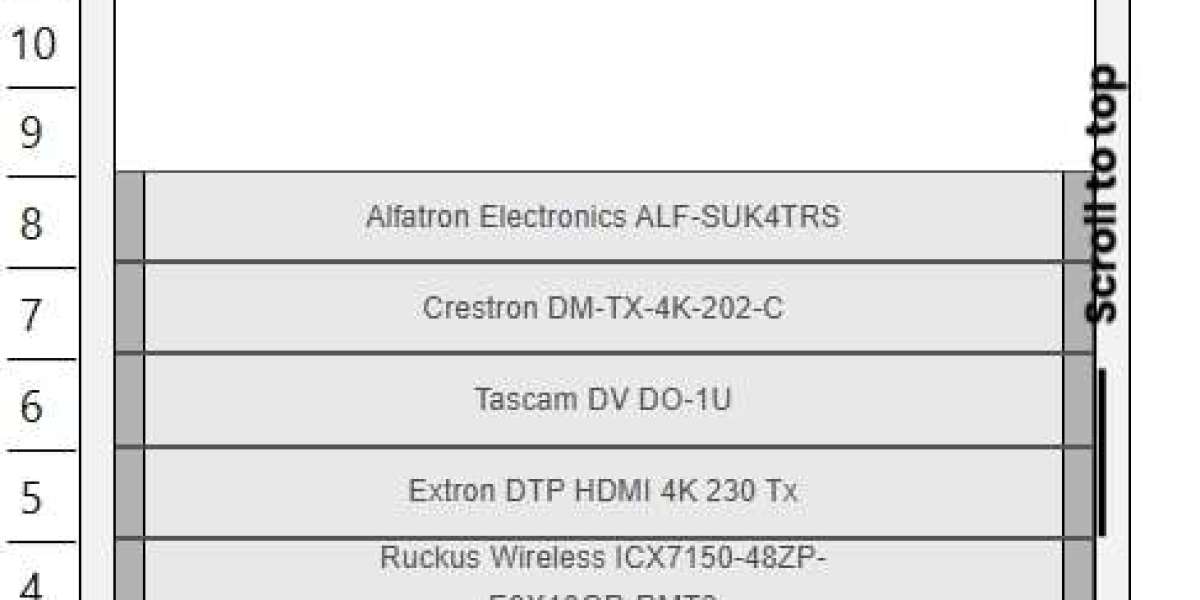XTEN-AV continues to provide innovative solutions that simplify IT and AV infrastructure management. One of the most effective ways to plan and maintain racks is by using editable rack diagrams. These diagrams allow teams to visualize server rooms, data centers, and AV installations while providing the flexibility to make changes as infrastructure evolves. With downloadable and editable diagrams, organizations can save time, reduce errors, and maintain accurate documentation.
In this blog, we will discuss the benefits of editable rack diagrams, how to use them effectively, and where teams can access reliable downloadable templates.
The Need for Editable Rack Diagrams
Server rooms, data centers, and AV racks house critical infrastructure that must be organized for optimal performance. A typical rack contains servers, switches, storage units, power distribution units, and other equipment. Poor planning can result in:
Inefficient space utilization
Airflow and cooling problems
Complex cabling that complicates maintenance
Increased downtime and operational risks
Editable rack diagrams solve these problems by providing a visual and flexible representation of rack layouts. Teams can download these diagrams, customize them according to their specific needs, and maintain a record of equipment placement and connectivity. This approach ensures accuracy, consistency, and scalability.
Benefits of Downloadable Editable Rack Diagrams
1. Flexibility in Planning
Editable diagrams allow teams to experiment with different layouts, device placements, and cabling configurations. This flexibility helps identify the most efficient use of space, optimize cooling, and plan power distribution before physically installing equipment.
2. Faster Deployment
Pre-made downloadable templates provide a head start for rack planning. Teams do not need to start from scratch and can adapt existing diagrams to fit the unique specifications of their server rooms or AV racks.
3. Collaboration and Teamwork
Editable diagrams can be shared among team members for collaborative planning. Multiple stakeholders, including IT engineers, AV specialists, and facility managers, can review, edit, and approve layouts. This reduces miscommunication and ensures everyone is aligned on the design.
4. Accurate Documentation
Rack diagrams serve as a living record of equipment placement, network connections, and power distribution. Editable diagrams can be updated whenever devices are added, removed, or moved, maintaining accurate documentation for maintenance, audits, and compliance.
5. Cost and Time Efficiency
Using editable and downloadable diagrams reduces the time spent creating layouts manually. It also minimizes errors that can lead to costly downtime, excessive cabling, or inefficient space utilization.
Key Features to Look for in Editable Rack Diagrams
When choosing editable rack diagrams, look for the following features to ensure they are practical and effective:
Predefined Templates – Diagrams that include common rack configurations and standard equipment.
Customizable Layouts – The ability to move, add, or remove devices as needed.
Layer Management – Separate layers for power, network, and AV connections for clarity.
High-Resolution and Scalable – Diagrams that can be enlarged or printed without losing quality.
Compatibility with Editing Tools – Support for common software like PDF editors, CAD tools, or specialized rack diagram software.
Downloadable Formats – Availability in formats like PDF, SVG, or editable image files for easy use.
Annotation Capabilities – Ability to add labels, notes, and specifications for each device.
How to Use Editable Rack Diagrams Effectively
Step 1: Assess Your Infrastructure
Start by evaluating your server room, data center, or AV racks. Identify the number of racks, types of equipment, power requirements, and cooling capabilities. This assessment ensures that your diagrams accurately reflect your environment.
Step 2: Choose the Right Diagram Template
Select a downloadable template that closely matches your rack configuration. XTEN-AV provides templates designed for flexibility and easy customization. Choose templates that allow layer management and annotation for better documentation.
Step 3: Customize the Layout
Adjust the diagram to fit your specific equipment and layout needs. Move devices, add new units, and ensure proper spacing for cooling and cabling. Include annotations for device specifications, serial numbers, and power connections.
Step 4: Collaborate with Your Team
Share the editable diagram with all relevant stakeholders. Use it as a reference during planning meetings to ensure everyone agrees on device placement, power distribution, and network connectivity. Collaborative editing reduces errors and ensures consistency.
Step 5: Test and Simulate
Use software tools to simulate airflow, cooling efficiency, and power distribution. Identifying potential issues in the planning stage prevents problems during installation and operation.
Step 6: Save and Maintain
Store the editable diagram in a central location accessible to your team. Update it whenever changes are made to the racks, such as adding new servers or reconfiguring network devices. Accurate, up-to-date diagrams are invaluable for maintenance, troubleshooting, and audits.
Where to Find Downloadable Editable Rack Diagrams
XTEN-AV Templates – Ready-made templates for server rooms, AV racks, and data centers. These diagrams are editable, cloud-accessible, and compatible with popular diagramming tools.
Manufacturer Resources – Many hardware vendors provide rack templates for their devices. These templates ensure accurate dimensions and specifications.
Open Source Libraries – Communities like GitHub or professional forums often provide editable diagrams in various formats.
CAD and Diagramming Software – Tools like AutoCAD or Visio often include downloadable rack diagram templates that can be customized.
Industry Publications – Some IT and AV publications provide sample diagrams for educational and professional use.
Best Practices for Downloadable Editable Rack Diagrams
Keep Layers Organized – Separate power, network, and AV connections to reduce complexity.
Use Standard Symbols – Follow industry standards for representing servers, switches, and other equipment.
Annotate Clearly – Include notes for device specifications, cabling types, and power ratings.
Review Regularly – Update diagrams whenever equipment or layout changes occur.
Back Up Diagrams – Maintain copies in multiple formats to prevent data loss.
Use Templates as Starting Points – Adapt existing templates instead of creating diagrams from scratch to save time.
Conclusion
Editable rack diagrams are essential tools for planning, documenting, and maintaining server rooms, data centers, and AV racks. By providing flexibility, collaboration, and accurate documentation, these diagrams help organizations reduce errors, optimize space, and maintain operational efficiency.
XTEN-AV offers a range of downloadable and editable rack diagram templates that are perfect for teams managing complex IT and AV infrastructure. With features such as layer management, annotation, and cloud accessibility, these templates enable professionals to plan effectively, collaborate seamlessly, and maintain accurate records.
By leveraging editable rack diagrams, organizations can streamline installation, improve maintenance workflows, and ensure that their infrastructure remains scalable and future-ready. Downloading and customizing diagrams is no longer just a convenience—it is a strategic approach to managing modern IT and AV environments efficiently.
Read more: https://avaisetupguide.renderforestsites.com/How-to-Draw-Rack-Diagrams-Like-a-Pro/














